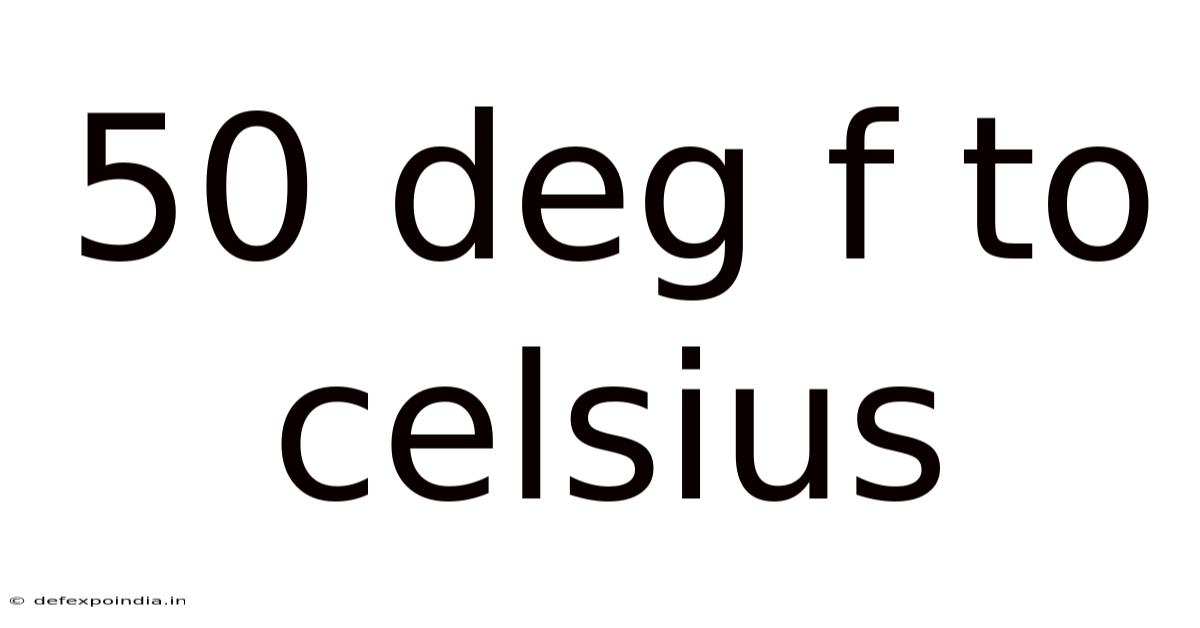50 Deg F To Celsius
defexpoindia
Sep 23, 2025 · 4 min read

Table of Contents
Converting 50°F to Celsius: A Comprehensive Guide
Many of us encounter temperature conversions in our daily lives, whether checking the weather forecast, baking a cake, or understanding scientific data. Converting between Fahrenheit (°F) and Celsius (°C) is a common task, and understanding this process is crucial for clear communication and accurate calculations. This article provides a comprehensive guide on converting 50°F to Celsius, exploring the underlying formula, practical applications, and addressing frequently asked questions. We'll delve into the history of these scales, providing context to the conversion process and highlighting the importance of accurate temperature measurement in various fields.
Understanding Fahrenheit and Celsius Scales
Before diving into the conversion, let's briefly revisit the history and characteristics of these two temperature scales. The Fahrenheit scale, developed by Daniel Gabriel Fahrenheit in the early 18th century, uses the freezing point of water as 32°F and the boiling point as 212°F at standard atmospheric pressure. This scale is still predominantly used in the United States.
The Celsius scale, also known as the centigrade scale, was developed by Anders Celsius in the 18th century. It uses the freezing point of water as 0°C and the boiling point as 100°C at standard atmospheric pressure. This scale is the standard temperature scale used internationally and in most scientific contexts.
The Conversion Formula: From Fahrenheit to Celsius
The conversion between Fahrenheit and Celsius is a linear transformation, meaning that the relationship between the two scales is a straight line. The formula to convert Fahrenheit to Celsius is:
°C = (°F - 32) × 5/9
This formula takes the Fahrenheit temperature, subtracts 32 (to adjust for the difference in freezing points), and then multiplies the result by 5/9 (to account for the different scaling between the two units).
Converting 50°F to Celsius: Step-by-Step
Let's apply the formula to convert 50°F to Celsius:
- Subtract 32: 50°F - 32°F = 18°F
- Multiply by 5/9: 18°F × 5/9 = 10°C
Therefore, 50°F is equal to 10°C.
Practical Applications of Temperature Conversion
The ability to convert between Fahrenheit and Celsius is essential in numerous fields:
- Meteorology: Weather reports often provide temperatures in both Fahrenheit and Celsius, requiring accurate conversion for international understanding and consistency.
- Cooking and Baking: Recipes may specify temperatures in either Fahrenheit or Celsius. Accurate conversion ensures the successful preparation of food items.
- Medicine: Body temperature is often measured in both scales, requiring precise conversion for accurate diagnosis and treatment.
- Engineering and Manufacturing: Many industrial processes require precise temperature control, demanding accurate conversion between Fahrenheit and Celsius for optimal performance and safety.
- Science: Scientific experiments and research often require precise temperature measurements and conversions for accurate data analysis and reproducibility of results.
Beyond the Basic Conversion: Exploring Temperature Extremes
Understanding temperature conversion is not limited to simple calculations. Let's explore some examples that highlight the importance of accurate conversion in extreme conditions:
- Extreme Cold: Consider the conversion of -40°F to Celsius. Using the formula: (-40°F - 32) × 5/9 = -40°C. This highlights a unique point where both scales coincide – -40°F is equal to -40°C. This is the only temperature where both scales are numerically identical.
- Extreme Heat: High temperatures require precise conversion for safety and planning. For instance, converting 100°F to Celsius gives us (100°F - 32) × 5/9 ≈ 38°C, illustrating a significantly high temperature that demands appropriate precautions.
These examples demonstrate the practical implications of accurate temperature conversion across a wide range of temperatures.
Frequently Asked Questions (FAQ)
Here are some frequently asked questions regarding temperature conversion:
-
Q: Why is there a difference between Fahrenheit and Celsius scales?
- A: The difference stems from the different reference points used to define the scales. Fahrenheit uses the freezing and boiling points of a brine solution and human body temperature as reference points, while Celsius uses the freezing and boiling points of pure water.
-
Q: Can I use an online converter instead of the formula?
- A: Yes, many online calculators and conversion tools are available. However, understanding the formula allows for greater comprehension and enables you to perform the conversion independently.
-
Q: Is it possible to convert Celsius to Fahrenheit?
- A: Yes, the reverse conversion formula is: °F = (°C × 9/5) + 32.
-
Q: Are there other temperature scales besides Fahrenheit and Celsius?
- A: Yes, the Kelvin scale is another widely used temperature scale, primarily in scientific contexts. It is an absolute temperature scale, meaning 0 Kelvin represents absolute zero, the theoretical lowest possible temperature.
Conclusion: Mastering Temperature Conversions
Mastering the conversion between Fahrenheit and Celsius is a valuable skill with diverse applications. Understanding the underlying formula allows for accurate and independent conversions, crucial in various fields ranging from everyday tasks to scientific research. The examples and FAQs provided further solidify this understanding, equipping you with the knowledge to confidently handle temperature conversions in diverse situations. Remember the key formula: °C = (°F - 32) × 5/9, and practice applying it to solidify your understanding. Accurate temperature conversion is not just a mathematical exercise; it's a key component of precise measurements and effective communication across various disciplines.
Latest Posts
Latest Posts
-
Convert 160 Cm To Inch
Sep 23, 2025
-
What Is 5 5kg In Pounds
Sep 23, 2025
-
179cm In Ft And Inches
Sep 23, 2025
-
0 4 Repeated As A Fraction
Sep 23, 2025
-
7 8 As A Percentage
Sep 23, 2025
Related Post
Thank you for visiting our website which covers about 50 Deg F To Celsius . We hope the information provided has been useful to you. Feel free to contact us if you have any questions or need further assistance. See you next time and don't miss to bookmark.